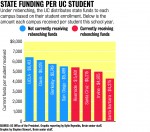The University of California will double the amount of state money used for a UC budget reform that attempts to equalize how state funds are distributed among campuses. The new funds will be distributed next year to the four campuses that currently receive the least amount of state funds. This progression in the implementation of the plan, known as rebenching, comes after UCLA and other campuses expressed concerns over the fairness of the proposal and the formulas used to allocate the money.
The reform, which was first implemented this year after being adopted by UC President Mark Yudof, ties the money given to each campus to student enrollment. Previously, state funds were allocated based on a complicated algorithm that often favored older campuses, such as UCLA and Berkeley.
Prior to rebenching, UCLA received the most state funds per student. The rebenching plan aims to eventually bring other campuses up to UCLA’s level of per-student state funding. Funds will not be redistributed among campuses, according to the proposal, and instead additional state funds the UC receives each year will be allocated to rebenching.
The rebenching plan would require about $36 million a year to fund the plan and is currently scheduled to be implemented over the next six years, said Jean-Bernard Minster, chair of the UC Committee on Planning and Budget.
Last year, the UC only allocated about $18 million for the rebenching plan because of the limited amount of additional state funds received that year. This amount was less than the University had planned to allocate to the plan each year.
This money was distributed to the four most underfunded campuses – Irvine, Santa Barbara, Santa Cruz and Riverside – while the remaining funds were distributed among all of the campuses. Currently, discussions are underway about whether to increase the amount of money allocated next year to make up for last year’s deficit or to distribute those funds over several years, Minster said.
Since rebenching relies on additional state funds allocated to the University, the plan received a boost this year because of the passing of Proposition 30 and the governor’s budget, which allocated more state funds to the UC.
The governor’s proposed budget for 2013-2014 allocates around $250 million in extra state funds to the UC, which helps create more stability for the UC budget and allows the rebenching plan to move forward, said Nathan Brostrom, executive vice president of UC business operations.
In years when the UC does not have enough additional state funds, money may not be allocated to rebenching, causing the six year plan to be adjusted, Minster said.
Yudof is also stepping down in August, which has led to speculation that rebenching may not continue under the next president, said Neal Garrett, chair of the UCLA Committee of Planning and Budget.
Brostrom, however, said that since there is widespread support for the plan from the UC, it is unlikely that the new president would stop the implementation of the plan.
The next step for the rebenching proposal is setting enrollment targets for the campuses, which will be the third and final part of the UC budget overhaul.
